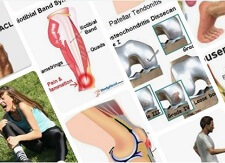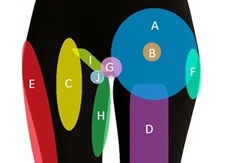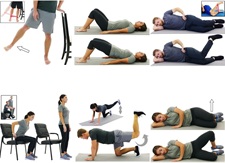- Home
- Hip Pain Diagnosis
- Groin Strain
Groin Strain
Written By: Chloe Wilson, BSc(Hons) Physiotherapy
Reviewed by: KPE Medical Review Board

A groin strain is a very common soft tissue injury that affects the inner thigh muscles.
Groin muscle strains frequently occur in sports that demand quick acceleration, sudden changes in direction, or explosive lateral movements.
However, they can also happen during everyday activities or due to a fall or awkward movement.
In this article, we will explore everything you need to know about groin strains, including what causes them, symptoms to look out for, how they are diagnosed, and the best treatment strategies, including exercises, recovery tips, and prevention strategies.
What Is A Groin Strain?
A groin strain refers to overstretching or tearing of the adductor muscles and may also be known as an adductor strain or pulled groin muscle.
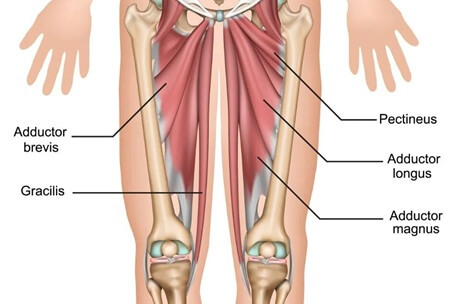
The adductors are a group of muscles found on the inner thigh that are responsible for pulling the legs together (adduction) and stabilising the hip and pelvis.
These muscles include adductor longus, adductor brevis, adductor magnus, gracilis, and pectineus.
Groin muscle strains are a common cause of inner thigh pain and typically affect the adductor longus muscle.
Muscles are made up of thousands of fibres that weave in together and allow the muscle to stretch and contract with movement, similar to an elastic band or bungee cord.
When one or more of the muscles is overloaded or overstretched, small tears can form in the muscle fibres, resulting in pain, inflammation, and weakness. Pulled groin muscle tears usually develop due to:
- Sudden Overstretching: where the muscle is quickly stretched beyond its elastic limit
- Abrupt Movement: when the muscle contracts forcefully at the same time as having to lengthen (eccentric contraction), usually from a sudden change of direction
- Chronic Overuse: which causes gradual wear and tear in the muscle fibres, reducing their elasticity and strength
Types of Groin Muscle Strain
A pulled groin muscle is typically graded based on the severity of the muscle damage:
- Grade 1 (Mild): Small tears in a few muscle fibres cause minor discomfort, stiffness, and minimal strength loss. There is little to no impact on movement with a grade 1 pulled groin muscle
- Grade 2 (Moderate): Partial tearing of the muscle fibres leads to moderate pain, swelling, bruising, and limited movement. Activities like walking or climbing stairs may be painful with a grade 2 groin muscle strain
- Grade 3 (Severe): A complete or near-complete tear of the muscle. This results in sudden, severe pain, significant swelling, bruising, and loss of function. Weight-bearing may be extremely difficult with a grade 3 groin strain

Common Causes of Groin Strain
A pulled groin muscle usually occurs when the adductor muscles are stretched beyond their capacity or subjected to sudden, forceful contractions.
Common groin strain causes include:
- Sudden changes in direction or rapid acceleration, common in sports like football, rugby, basketball and tennis
- Explosive lateral movements or jumping e.g. martial arts
- Overstretching the inner thigh muscles e.g. during flexibility or agility drills
- Insufficient warm-up before intense activity
- Sudden increase in activity levels
- Muscle fatigue or weakness, particularly in the adductors or core muscles
- Muscle imbalances between hip adductors and abductors, or tight hip flexors or hamstrings, leading to overcompensation
- Previous groin injuries, which can leave the muscles more prone to future strains if they aren’t properly rehabbed
Whilst sporting activities tend to be the most common causes of groin strain, they can affect anyone.
Groin Strain Symptoms
Symptoms of groin muscle strain can vary depending on the severity and specific muscle involved. Common pulled groin symptoms typically include
- Sudden sharp or stabbing pain in the groin or inner thigh during movement or exertion
- Pain or tenderness along the inner thigh, especially near the pubic bone
- Swelling or bruising, which may appear within hours to days
- Muscle weakness and difficulty moving the leg, especially bringing it across the body
- Stiffness or reduced range of motion in the hip or thigh
- Pain when performing resisted adduction e.g. pressing knees together
- A popping or snapping sensation at the time of injury in more severe strains
Groin strain symptoms often worsen with activities like sprinting, cutting, pivoting, or kicking, and may linger if the injury isn’t properly treated.
Pulled
Groin Muscle Diagnosis
Diagnosing a groin strain involves a combination of clinical evaluation and, when needed, imaging tests to rule out other possible causes of groin pain.
A physiotherapist or doctor will begin by taking a detailed history, including how the injury occurred, symptoms experienced, and any previous pulled groin muscles. This is followed by a physical examination to assess muscle strength, flexibility, and areas of tenderness.
Typical in-clinic tests for a groin muscle strain include:
- Palpation: Gentle pressure is applied along the inner thigh to locate the exact point of tenderness or swelling.
- Range of Motion Tests: Passive abduction (moving the leg outward) or stretching the inner thigh can reproduce pain if the adductor muscles are injured.
- Resisted Adduction Test: The patient attempts to bring their legs together against resistance. Pain or weakness with this groin strain test may suggest an adductor strain.
While many groin muscle strains can be diagnosed through clinical exam alone, imaging may be used in more complex cases:
- Ultrasound can identify muscle tears, fluid collection, or tendon involvement.
- MRI gives a detailed picture of soft tissue structures and is helpful in severe or persistent cases, or when ruling out tendon avulsion or bone stress injuries.
- X-rays are not usually required unless there is suspicion of a fracture or bone-related condition.
Differential Diagnosis
Groin pain can stem from a variety of sources, so it is important to rule out other potential conditions with a suspected groin muscle strain, such as:
- Hip Labral Tear
- Femoroacetabular Impingement (FAI)
- Inguinal or sports hernia
- Osteitis pubis
- Referred pain from the lumbar spine or sacroiliac joint
Accurate diagnosis of a groin strain ensures the most effective treatment and helps prevent recurrence.
#CommissionsEarned from Amazon on qualifying purchases
Groin Strain Treatment
Pulled groin treatment will depend on the severity of the injury, but most cases respond well to conservative care. The best treatment for groin strains usually involves a combination of:
- Rest and Activity Modification: Avoid movements that trigger pain. Relative rest (not complete immobility) is key in the early stages of a pulled groin muscle. If you are having trouble walking, you may need to use crutches for a few days
- Ice Therapy: Apply an ice pack wrapped in a cloth for 15-20 minutes every 2-3 hours in the first 48–72 hours to reduce groin pain and swelling
- Compression and Support: Elastic wraps or groin supports can help minimise swelling and provide comfort during movement
- Elevation: Raising the leg can help reduce fluid build-up
- Pain Relief: Paracetamol or NSAIDs (if approved by a doctor) may reduce pulled groin muscle pain and inflammation
- Manual Therapy: Soft tissue massage and joint mobilisation can improve flexibility and reduce scar tissue, which helps to reduce the likelihood of recurrent injuries and improve hip range of motion
- Gradual Return to Exercise: Begin with low-load exercises and progressively increase intensity under the guidance of a physiotherapist
- Surgery (in rare cases): For severe or recurrent Grade 3 strains that don't respond to conservative treatment, surgical repair may be necessary. Surgical treatment for groin strain typically involves reattaching torn muscle fibres or reinforcing the tendon attachment, followed by a structured rehab program.
The earlier you start groin strain treatment, the quicker you are likely to heal and the better the long-term outcome.
Groin Strain Exercises
Groin strain exercises are a key part of pulled groin treatment. Once the acute pain phase subsides, exercises play a crucial role in restoring strength, flexibility, and neuromuscular control.
1. Groin Strain Strengthening Exercises
The best place to start with groin strain exercises is to focus on hip strengthening exercises.
- Isometric Adduction: Lie on your back and place a pillow between your knees, then gently squeeze and hold.
- Side-Lying Leg Lifts: Lie on your side and lift the bottom leg upward to target the adductors.
- Standing Hip Adduction with Resistance Band: Anchor a resistance band and move your leg toward the midline against resistance.

As well as strengthening the adductor muscles, it also helps to do glute strengthening, quads strengthening, and hamstring strengthening as part of your groin strain treatment
2. Groin Strain Stretches
Groin strain stretches should only be started once resisted adduction is pain-free. If you start stretching too early, you can actually make things worse and slow down the adductor strain healing process.
- Adductor Stretch (Side Lunge): Step to the side, keeping one leg straight and the other bent, to stretch the inner thigh.
- Butterfly Stretch: Sit with the soles of the feet together and gently press the knees toward the floor to open the hips.
- Frog Stretch: Kneel with knees wide and feet turned out, gently pushing hips backward to stretch inner thighs.
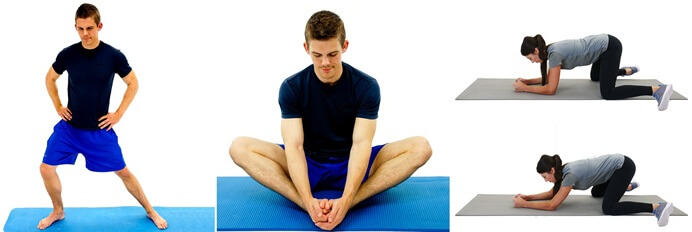
As well as doing groin strain stretches, it is also worth doing hamstring stretches as part of your pulled groin muscle treatment
Progress should be gradual with groin strain exercises, ensuring pain-free execution before advancing to dynamic movements like hopping, running, or sport-specific drills.
Groin Strain Recovery Time
Most people make a full adductor strain recovery and long term problems are rare. Groin strain recovery time will vary based on the injury grade, treatment approach, and individual healing capacity. Typical pulled groin muscle healing time is as follows:
- Grade 1 Groin Strain Recovery: Typically resolves within 1–4 weeks with early rehab
- Grade 2 Groin Strain Recovery: May take 3–6 weeks with progressive loading and therapy
- Grade 3 Groin Strain Recovery: Severe tears may require 8–12+ weeks, and in rare cases, surgical repair
Returning to sport or high-level activity too soon after an adductor strain can lead to re-injury. It can be frustrating to have to wait but a phased rehabilitation plan ensures safe progression and you should get medical clearance before returning to full activity.
How To Prevent Groin Muscle Strain
Preventative measures are key to avoid a pulled groin muscle, especially for athletes and active individuals:
- Warm Up Thoroughly: Include dynamic stretches, light cardio, and adductor activations before intense activity
- Regular Stretching: Increase and maintain flexibility in the hips, groin, and hamstrings.
- Strengthen Supporting Muscles: Incorporate resistance training for glutes, core, hip flexors, and adductors.
- Balance Training: Improve coordination and control through single-leg and balance exercises.
- Listen to Your Body: Avoid overtraining and take rest days to allow muscles time to recover.
- Rehab Previous Injuries Fully: An unresolved pulled groin muscle significantly increase the risk of recurrence.
Whilst it is not possible to completely illuminate the risk of a pulled groin muscle, especially in sports, following these tip helps to reduce the risk of injury.
Groin Strain Summary
A groin strain, aka pulled groin muscle or adductor strain, is a common and often painful injury affecting the inner thigh muscles. It typically occurs due to sudden movements, overstretching, or muscle imbalances.
With early diagnosis, proper treatment, and a comprehensive rehabilitation programme, most people recover fully from a groin muscle strain and return to normal activity.
If you suspect a groin strain, do not ignore the pain. Get assessed, start treatment promptly, and follow a targeted exercise plan to ensure a full and lasting recovery.
You may also be interested in the following articles:
- Inner Thigh Pain
- Front Hip Pain
- Hip Flexor Strain
- Pulled Quad Muscle
- Hip Muscle Anatomy
- Inner Knee Pain
- Snapping Hip Syndrome
Related Articles
Knee Pain Diagnosis
March 27, 2025
Hip Pain Diagnosis
September 16, 2025
Hip Strengthening
September 24, 2025
Last Updated: September 24th, 2025
Next Review Due: September 24th, 2027
